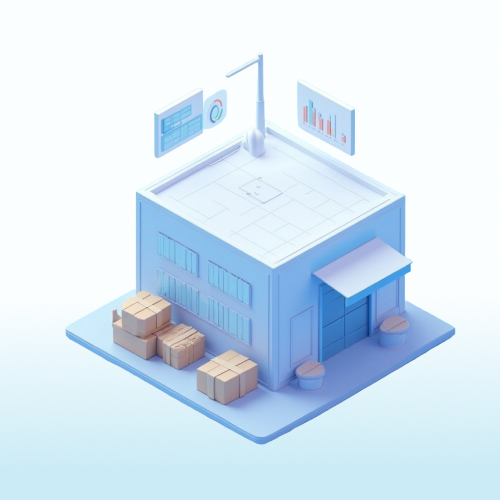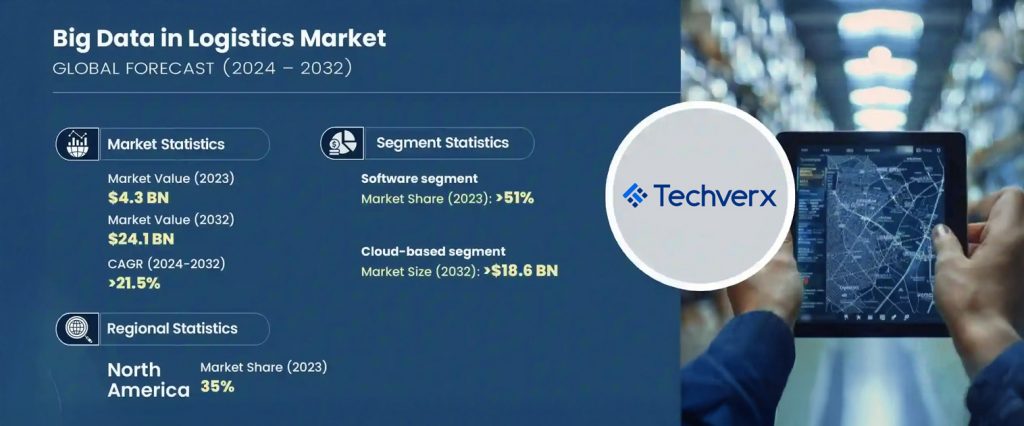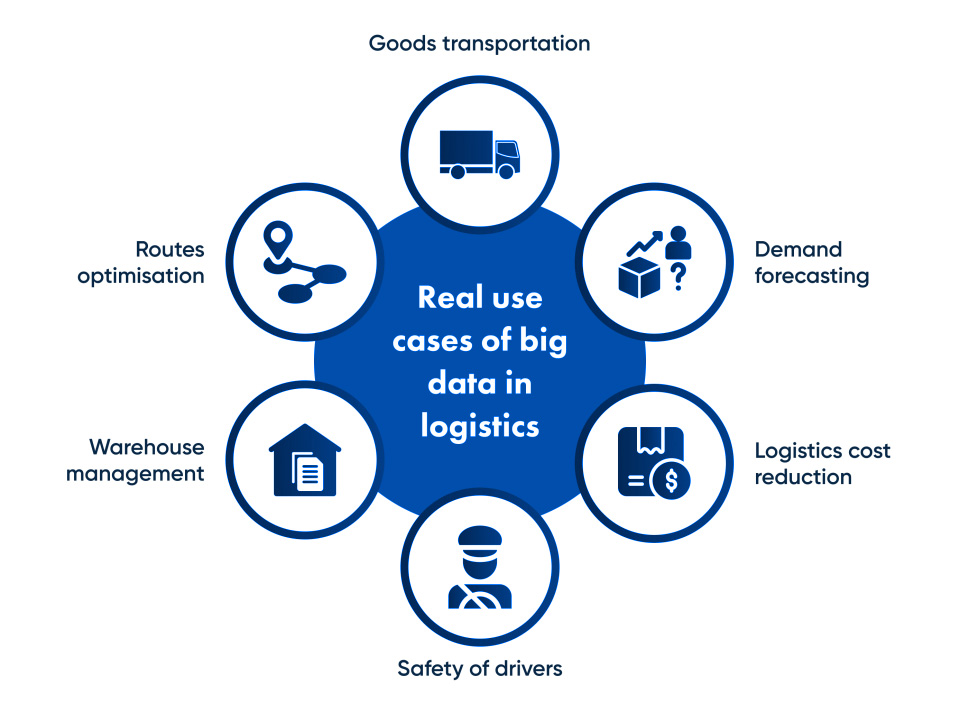
Big Data in Logistics: Unlocking New Possibilities

Big data has unlocked vast opportunities across numerous industries, and logistics is no exception. Allied Market Research reports that the global logistics market, valued at $7,641.20 billion in 2017, is projected to soar to $12,975.64 billion by 2027. This remarkable growth highlights how logistics providers are increasingly leveraging data analytics to streamline and optimize their operations.
As the logistics sector grows more intricate and dynamic, challenges emerge at multiple points within the supply chain. This complexity makes transportation and logistics an ideal industry for the application of big data analytics.
Modern consumers expect faster deliveries, competitive pricing, and complete transparency. To meet these expectations, logistics companies must collect and analyze data from diverse sources, ensuring key performance indicators (KPIs) are accurately measured. Such analysis empowers companies to identify optimization opportunities through actionable, data-driven insights.
In this article, we’ll explore the transformative role of data analytics in logistics and supply chain management. But before diving into its applications, let’s first define what big data actually means.

Big Data in Logistics: The Concept
Big data refers to massive, complex datasets that are too vast for traditional data processing systems to handle effectively.
These datasets are categorized as structured or unstructured. Structured logistics data is predefined, easily searchable, and generally numerical. In contrast, unstructured data lacks a fixed format, making it more difficult to process with conventional tools, it can include both textual and non-textual content.
While big data has matured in many industries, its impact on logistics is just beginning. Cloud computing now provides scalable storage and processing power, while graph databases help organize complex relationships among data points, enhancing performance, flexibility, and agility within the supply chain.
Ultimately, what matters is not the size or type of data available, but how companies use analytics to derive insights that improve decision-making. Without meaningful analysis, big data holds little value. With this foundation established, let’s now explore the role of data analytics in logistics.
The Crucial Role of Data Analytics in Today’s Supply Chain
Before examining specific applications, it’s important to understand how data analytics has reshaped supply chain management at its core. Modern logistics strategies rely heavily on insights derived from data to increase efficiency, cut costs, and enhance customer experiences.
Data analytics empowers logistics companies to detect patterns within vast datasets, resulting in more precise demand forecasting and informed strategic planning. By adopting advanced analytical methods, organizations can uncover inefficiencies across their supply chains and act on them with targeted improvements.
Applications of Big Data Analytics in Logistics

Today’s logistics landscape has evolved far beyond traditional transportation. It is now a highly intelligent, data-driven ecosystem where insights define competitiveness. Data analytics is at the heart of this shift, providing unparalleled visibility and control across supply chain operations.
1. Route Optimization: Smarter Navigation
Route optimization no longer means simply finding the shortest path. Instead, it’s about creating the most efficient, cost-effective journey possible. By incorporating data such as real-time weather, traffic conditions, delivery histories, and vehicle performance, companies can calculate routes with incredible precision.
This reduces fuel costs, shortens delivery times, and allows businesses to anticipate disruptions before they occur. Real-time route adjustments transform logistics from reactive problem-solving into proactive management.
To implement route optimization effectively, companies must track logistics data like:
- Frequency of customer orders
- Number of available vehicles
- Distance between pick-up and drop-off points
- Regional order density
2. Demand Forecasting with Advanced Analytics
One of the most valuable uses of data analytics is accurate demand forecasting. By analyzing historical sales, market patterns, and seasonal shifts, companies can predict future needs with striking accuracy.
This helps balance inventory levels, prevent shortages or surpluses, and streamline supply chain efficiency. Advanced models factor in multiple variables to capture market dynamics and evolving consumer behavior. Many leading retailers and manufacturers now rely heavily on analytics-driven forecasting for a competitive edge.
3. Last-Mile Optimization
The final delivery stage, moving goods from a warehouse to a customer’s doorstep, accounts for as much as 41% of total supply chain costs. Optimizing this stage is essential for customer satisfaction.
By analyzing real-time logistics data, companies can refine processes and address external factors quickly. DHL’s MyWays initiative, for example, uses a mobile app and data analytics to crowdsource deliveries, connecting people traveling along certain routes with packages needing delivery, similar to Uber’s ride-sharing model.
4. Enhanced Tracking and Visibility
Data analytics has elevated package tracking beyond basic “track-and-trace” systems. Today, customers and businesses alike enjoy real-time visibility into shipments, including automated updates when vehicles stop en route.
Technologies like GPS, RFID, and barcodes enable real-time traffic monitoring, scheduling efficiency, and automated alerts when deliveries are close to their destination. The introduction of IoT sensors, adds even more control by monitoring conditions such as temperature and humidity inside transport vehicles.
5. Smarter Warehouse Management
Legacy systems alone are no longer sufficient for warehouse management. Consumers now expect instant product availability updates and real-time delivery information.
By integrating analytics, managers gain continuous visibility into operations, spotting bottlenecks and solving problems quickly. Industry leaders like Amazon and Alibaba have redefined warehouses as strategic assets, using analytics to forecast demand, optimize space, and reduce inefficiency.
6. Better Inventory Management
Strong inventory management underpins supply chain success. Data analytics provides real-time stock visibility, helping avoid both overstocking and understocking.
By tracking data from multiple sources, companies can identify slow-moving items, optimize replenishment cycles, and forecast seasonal demand. These insights reduce carrying costs, improve cash flow, and ensure customer needs are consistently met.
7. Managing Perishable Goods
Retailers dealing in perishable goods operate with slim margins and cannot afford waste or contamination. IoT sensors and barcodes make it possible to monitor product quality in real time throughout the supply chain. This ensures that fresh goods reach consumers safely and efficiently, protecting both brand reputation and profitability.
8. Elevating Customer Service
Today’s customers are more informed and demanding than ever. Delays and limited service coverage often lead to dissatisfaction.
Data analytics helps companies better understand customer expectations by analyzing feedback from surveys and social media. Amazon, for instance, relies on analytics to interpret customer behavior and reviews, enabling it to deliver exceptional service and build lasting loyalty.
9. Address Verification and Standardization
Accurate customer address data is vital. Errors in formatting or spelling can disrupt logistics operations. Address verification software powered by analytics, such as SmartyStreets, validates and standardizes addresses using APIs and online tools. This ensures accuracy and boosts overall logistics efficiency.
10. Predictive Maintenance
Analytics has revolutionized fleet management by enabling predictive maintenance. Using sensor data, past maintenance logs, and AI-driven insights, companies can anticipate failures before they happen.
This reduces unexpected breakdowns, extends vehicle life, and cuts costs by optimizing service schedules, transforming maintenance from reactive to strategic.
11. Strategic Network Planning
Given the volatility of logistics markets, companies must adopt flexible, forward-thinking strategies. Analytics tools support location planning, transport network optimization, and warehouse utilization, helping businesses reduce costs and strengthen their networks.
12. Capacity Planning and Forecasting
Capacity planning remains one of logistics’ toughest challenges. Companies need accurate demand and distribution data to plan effectively.
With AI and advanced analytics, capacity planning is now far more precise. Real-time forecasting tools reveal emerging trends, allowing businesses to align transportation and storage capabilities with actual demand instead of relying on assumptions.
The Future of Data Analytics in Logistics
As technology advances, data analytics will play an even greater role in logistics. The integration of AI and machine learning promises smarter predictive and prescriptive models, enabling supply chains to move toward autonomous decision-making.
The growing use of IoT sensors and real-time data connectivity will generate deeper insights, further optimizing logistics operations. Companies investing in analytics today will be tomorrow’s leaders, shaping the future of logistics through innovation and intelligent supply chain management.
How Techverx Powers Data-Driven Logistics
At Techverx, we specialize in helping logistics and supply chain companies unlock the full value of their data. Our services are designed to deliver the agility, efficiency, and transparency that modern logistics demands:
- Data Engineering & Integration – Building reliable pipelines to unify structured and unstructured logistics data across platforms.
- Advanced Analytics & Visualization – Turning raw logistics data into real-time dashboards and predictive insights for smarter decision-making.
- AI & Machine Learning Solutions – Enabling predictive maintenance, intelligent warehousing, and customer-centric personalization through advanced models.
- IoT & Real-Time Monitoring – Connecting sensors and devices for shipment visibility, last-mile optimization, and quality control.
- Cloud Implementation & Scalability – Deploying secure, scalable cloud solutions with AWS-certified expertise.
- ERP & Microsoft Dynamics 365 Consulting – Optimizing ERP workflows, solving system inefficiencies, and driving smarter inventory and network planning.
With a team of seasoned engineers and consultants, Techverx empowers logistics businesses to transform raw data into business intelligence, cutting costs, increasing transparency, and delivering exceptional customer experiences.
Conclusion: Turning Data into a Competitive Advantage
Big data and advanced analytics are no longer optional in logistics, they’re the foundation of modern supply chain management. From predictive maintenance to last-mile optimization, the ability to transform raw information into actionable insights determines who stays ahead in an increasingly complex, customer-driven market.
As technology evolves, the companies that embrace data-driven decision making today will shape the logistics industry of tomorrow, reducing costs, improving efficiency, and exceeding customer expectations.
That’s where Techverx comes in.
We partner with logistics and supply chain organizations to unlock the full power of their data. Whether it’s integrating IoT sensors for real-time visibility, leveraging AI/ML models for forecasting, or deploying Microsoft Dynamics 365 to streamline ERP and inventory, Techverx ensures you have the right tools, processes, and expertise to thrive in a data-first world.
Ready to future-proof your logistics operations with data-driven intelligence? Connect with Techverx and let’s make it happen.
Hiring engineers?
Reduce hiring costs by up to 70% and shorten your recruitment cycle from 40–50 days with Techverx’s team augmentation services.
Related blogs


